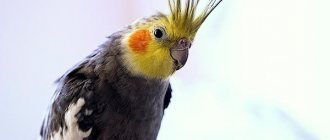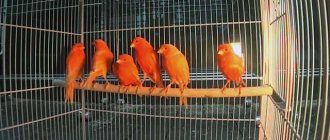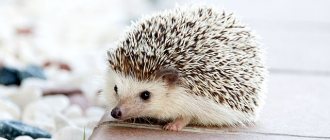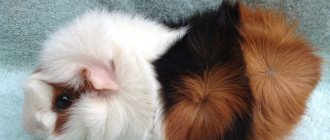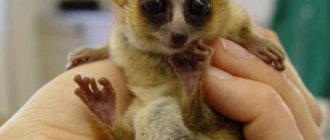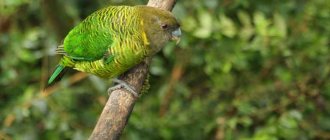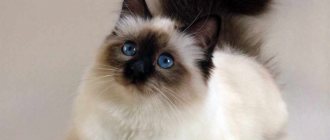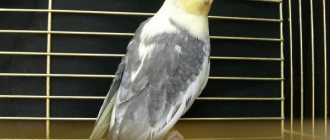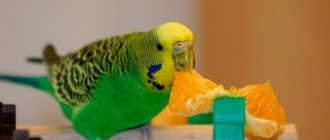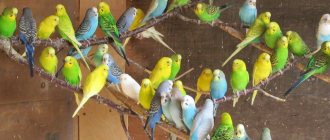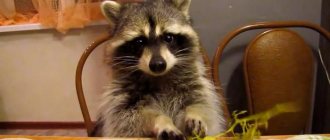Selection, placement and arrangement of the cage
If you properly organize the care of lovebirds, then lovebirds live well at home. And indeed it is! After all, here they feel comfortable, nothing threatens them, and they have good health. They are fed, watered, and their well-being is monitored. As a rule, under such careful care from the owner, parrots live a long time.
Where to put?
The cage plays a huge role in keeping and caring for lovebirds at home. Or rather, its selection, placement and arrangement. Of course, it is important to place it in the right place. It should be a warm, quiet, calm and windless place . In addition, it should be located where it can be approached without problems . After all, by providing proper care, an attentive owner will undoubtedly want to play and communicate with the lovebird. See if he's doing well. And regular feeding can be difficult if the cage is placed incorrectly.
Sizes and shapes
Now about the dimensions. The cage should be spacious . In it, the parrot should open its wings freely and move. Otherwise, rickets and developmental inhibition cannot be avoided. So, the optimal cage size for a couple is 500 cm by 100 cm . If you plan to breed birds, then you need to provide a wider cage. Proper breeding and reproduction of lovebirds cannot be carried out in a small space.
It is most convenient to choose a cage with a retractable bottom for quick care. This allows you to avoid spending a lot of time and effort on changing paper or sand along with bird excrement.
Attention! You cannot place magazines or newspapers on the bottom of the cage , as text or pictures are printed on them. Because of this, intoxication of the bird is possible. Proper home care for lovebirds involves using clean writing paper.
It is important to choose a rectangular cage , not with rounded edges.
Even people need their own corner to collect their thoughts and take a break from prying eyes. The same goes for parrots. They can hide in cages with corners, getting rid of the stress and danger that arises.
Cage equipment
What should be provided in a building where lovebirds are kept? Care and maintenance must be carried out in cages with trays (pull-out bottom). This design will greatly facilitate the work of cleaning the home for birds. It is best if the pallet is made of iron or sheet aluminum. The plywood bottom will quickly rot from the water thrown by the parrots.
It is also necessary to place perches in the cage. Their diameter should be such that lovebirds cannot completely wrap their fingers around them (1.5-2 cm). The best perches for parrots are those made from straight and even branches of deciduous trees. If the twigs were brought from the forest, then before placing them in the cage they should be treated with boiling water to remove parasites. Do not use plastic poles. They are harmful to birds and contribute to the formation of calluses on their feet.
There should also be a feeder and a drinker in the cage. They should not be placed next to each other to avoid wetting the food, or under the perches, since in this case bird droppings may get into the contents of the containers. Various containers can be used for drinking bowls and feeders (jars, salt shakers, cuvettes for photographs, etc.).
At the bottom of the cage there must be sawdust or a layer of clean river sand. You should not put newspapers on it, because printing ink is harmful to birds. Ordinary writing paper will not be suitable for these purposes. Lovebirds will very quickly tear it into small pieces.
Bathing
Care and maintenance of lovebirds at home involves constant, scheduled bathing. Birds love to bathe, cleaning their feathers from accumulated dust and dirt. This helps them maintain good health and develop their skeletal system. Thanks to bathing, their appearance also improves.
To properly maintain lovebirds, you need to know the rules for washing them. In winter, you should bathe a couple of times every seven days in a separate bathing suit. Each parrot should have a separate bath with 27-degree water. It is necessary to take the birds for bathing to places where there are no drafts. Otherwise, there is a risk of catching a cold. Do not pour water into the bath higher than two centimeters and do not add any detergents.
It is better to take the bird for a bath before lunch time. Then the lovebird will be able to dry thoroughly by night. Parrots should not be dried with a hairdryer. This can lead to pneumonia and other illnesses. In summer, lovebirds should be bathed daily.
Features of keeping lovebirds
The bird will get used to the new environment for about two weeks. At this time, she needs to be allowed to get used to it and not be imposed on. Soon the curious bird itself will fly up to its owner to get acquainted.
Keeping parrots is quite simple . The main thing is that the room is warm and there are no drafts. This is especially important when the bird is bathing. In summer, the cage with lovebirds can be taken out onto the balcony or into the garden. Sunbathing promotes the production of vitamin D, which is very important for the health of birds. Part of the roof of the cage should be covered with a blanket to create shade where the birds can hide from the sun.
In winter, when the heating radiators are running, the air in the apartments is very dry, from which the parrots suffer greatly. An air humidifier can help them, the work of which will be useful not only for birds and for people living in the apartment.
When caring for birds, you need to ensure that there is no droppings in the water bowl, feeders, toys and perches. Drinkers, feeders and trays need to be washed every day. All cage equipment is washed once a week.
Birds require special attention during the molting period. Lovebirds molt for the first time at five to six months. Molting can continue for up to two months. The growing feathers at this time cause the parrots to constantly itch, so the birds often itch, preen themselves, and become irritable. To maintain the body during this period, lovebirds need vitamins and mineral supplements. All this can be bought at pet stores.
Leisure, games, communication
Parrots love to communicate, play and interact in every possible way with other birds and humans. They are easy to train. If desired, they can be trained to dance, juggle rings and perform other tricks. But you need to start your leisure time, communication and training with any pet by accustoming it to human hands. The best way to do this is with treats. At the same time, birds need to be trained to handle from a young age.
Attention! When training your pet to handle, you should not touch the parrots’ legs or wings. They perceive such actions as the beginning of a fight. Therefore, aggression occurs.
Birds need communication constantly. It is advisable that they communicate with both humans and other birds. Communication is an important component of proper care and maintenance of lovebirds at home. After all, domestic parrots often suffer from loneliness. For this reason, it is better to keep lovebirds in pairs. A person should communicate with birds quietly, without sudden movements. It is difficult to teach lovebirds to speak, since they usually remember about 10 words.
How to care for your pet
Attention from the owner must be constant. At first, the birds are afraid of new acquaintances, shy away from hands and sit in their cage forever. This is temporary.
If there is a lot of emotional involvement in the new family member, the parrot will make contact sooner and will stop hiding in a corner when people appear. Doors must always be open.
Subsequently, the birds will freely stretch their wings, flying around the room, which is very useful and helps to avoid many diseases.
How to properly care for a parrot
Proper diet: what you can and cannot eat
Grain mixtures are the basis of nutrition, but there is one caveat. Wavy food is not suitable for a pair of lovebirds. Need food for medium parrots. The grain must be sifted. In addition to the base, various additives are required:
- vegetables (carrots, cauliflower, broccoli, radishes, turnips and the like);
- fruits (bananas, peaches, kiwi, cherries, apricots, plums, tangerines (all pitted);
- rowan, cucumbers, peanuts, walnuts.
It is very useful to give oats and millet sprouted. In our latitudes, tropical residents adore the dandelion leaf.
The daily intake of food is two to three teaspoons for each person.
You should not offer parrots lemon slices, although the water is enriched with a couple of drops of juice to prevent infections. For them, bird cherry is a potent poison; the seeds contain hydrocyanic acid. This dose does not harm people, but kills birds.
What to feed a lovebird
Cleaning the cage
In the morning or evening, you need to wash the tray, feeders and drinkers with a sponge under hot water without chemical detergents. Once a week, wash the entire bottom, wipe the poles, rods, and toys with a damp cloth.
Every month you need to disinfect everything with a decoction of calendula or chamomile, you can use a weak solution of manganese. This helps get rid of germs, bacteria, even parasites.
Read also
How to wash a parrot's cage
Bathing
Bathing is a great pleasure for lovebirds. You need a suitable bath, otherwise they will dive into the drinking bowl and into any other containers in which they find liquid.
Bird games and training
Parrots are more likely to learn to pronounce sounds from a child or woman with a high-pitched voice. To do this, devote ten minutes to exercise every day before feeding. The thin voice is mesmerizing.
The lesson should be more like a normal conversation; you shouldn’t get angry and stubbornly demand anything. The parrot will not immediately repeat the whole phrase. You need to start with individual sounds and short words.
You should always fill what is said with emotion and try to maintain intonation. Many people use a voice recorder and other aids. However, communication with a living person is much more pleasant for birds and brings more results.
Vaccination
The vaccination is almost always combined, capable of eliminating rabies, adenovirus, psittacosis, parainfluenza virus, and sometimes leptospirosis.
It is given once, then on a schedule every three or four weeks until a certain age. Before six months of age, it is mandatory to be vaccinated against rabies.
Diseases and prevention
Basically, lovebirds rarely get sick because they are removed from the outside world. However, it happens. Diseases can be divided into three classes:
- Non-contagious (injuries, vitamin deficiency, obesity, improper molting, problems with egg laying, swelling of the joints, etc.).
- Parasitic diseases affecting the food tract, skin, eyes, paws, beak, down and feathers. They are caused by helminths and various mites.
- Contagious when you urgently need to stop contact with relatives.
Read also
Diseases of lovebirds and their symptoms
In any case, an ornithologist is needed immediately as soon as the first symptoms are noticed. Prevention requires only careful care, proper diet and hygiene.
Sleep and rest
Birds sleep at least ten hours every day, and in winter, up to fourteen. They fall asleep at dusk. Therefore, in the summer you can create the onset of night artificially, thus helping the birds to rest. Sometimes during the day they settle down on their perch, legs tucked under, to take a nap. There is no need to interfere with them, there is also nothing to worry about.
Diseases and prevention
Parrots, like all other birds, are susceptible to various diseases. Most often birds get sick:
- obesity and rickets;
- hypovitaminosis or vitamin deficiency;
- coccidiosis;
- worms and feather eaters;
- knemidocoptic mange (scabies, gamas and scabies mites);
- psittacosis;
- salmonellosis;
- aspergillosis;
- excessive shedding;
- Newcastle disease, manifested by fever, lack of appetite and difficulty breathing;
- Eschechiriosis due to intestinal colibacteria;
- atypical avian plague;
- parasitic effect of roundworms;
- trichomoniasis;
- tumorous;
- one-sided paralysis;
- benign and malignant tumors;
- impaired feather growth;
- French molt;
- goiter inflammation;
- gout, rhinitis, laryngotracheitis, bronchopneumonia;
- constipation and diarrhea;
- self-plucking, scabies and plucking;
- namin and hyperkeratosis.
In addition, they can be poisoned by low-quality food, get injured, and become aggressive. This is also important to remember for a person keeping lovebirds.
Disease prevention will be:
- Constant disinfection of the cage with all equipment using a solution of formaldehyde with bleach.
- Regular varied and balanced diet.
- Keeping the lovebird in constant motion to avoid obesity and rickets.
- Systematic inspection of the cage for the integrity of the things in it to avoid possible injury.
- Periodically trim claws or beaks using sharp scissors.
- Disinfection of a cage using sodium solution and creolin after the death of a parrot.
Thus, if you put into practice what is written above, your feathered friend will live a long and happy life. Proper maintenance and care of masked parrots, rosy-cheeked parrots, Fisher's lovebirds and others is possible only if these rules are followed. Take care of your winged friend. Then he will be happy and will delight you, your family members and your guests.
Nutrition
The usual food for lovebirds is 2-3 teaspoons of grain mixture, which is given to the birds throughout the day. It is worth remembering that young parrots eat more, but you need to make sure that they do not overeat. Their portion should not exceed four teaspoons per day. To feed the birds in the cage, you can hang millet ears or honey crackers. In this case, the volume of the mixture will need to be reduced. In addition to the main grain food, lovebirds are recommended to be given fruits and vegetables. They are grated on a large grater, hung in the form of garlands, attached to a cage with a clothespin, etc.
It is recommended to offer lovebirds porridge made from millet and buckwheat, pearl barley and rice. They are boiled in water without adding sugar or salt. You can add a little grated carrots, honey, vegetable or fruit puree to the porridge. Legumes are beneficial for birds due to their rich protein content. However, they must first be soaked in several waters and boiled for an hour.
Parrots can get all the necessary vitamins, minerals and fiber from fresh greens, which should also be present in the diet. Birds enjoy eating spinach and young nettle leaves, dandelion and lettuce. Lovebirds can also be given shoots of woodlice, which grows in damp places. Parrots need only high-quality food that is free of dust and foreign impurities.
Sleep patterns when living at home
Being in captivity, a pet often cannot navigate the daylight hours; the peculiarities of the Russian climate are also very different from the native conditions of the bird. Therefore, the owner’s task is to create artificial conditions close to the natural regime. Understanding how much parrots usually sleep in the wild will help normalize your pet's routine.
A significant part of a parrot's sleep occurs at night, and usually owners go to bed later and get up earlier than their pets. Therefore, it is recommended to cover the cage with a thick fabric cape at night - this way you can turn on the light without disturbing the bird. It is better not to use heavy synthetic fabrics - it is important to ensure sufficient air flow so that the pet does not suffocate.
You need to calculate the number of hours of sleep according to the time of year. In summer, parrots are more active and energetic, they need less time to regain strength - sleep can be about 10 hours a day. In winter, the metabolism slows down, the bird needs longer rest, about 14 hours. During daytime sleep, it is also better to cover the cage so that the pet is not disturbed.
